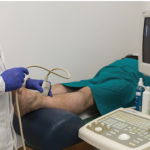
g0d4ather / SHUTTERSTOCK.COM
SAN DIEGO—In a roundup of current research in rheumatoid arthritis (RA) presented at the 2017 ACR/ARHP Annual Meeting Nov. 3–8, Mark C. Genovese, MD, professor of medicine in the Division of Immunology and Rheumatology at Stanford University, Palo Alto, Calif., urged his audience to reflect on the impact therapy advances have made on RA. “In a relatively short period of time, various therapies, strategies and novel molecular entities have resulted in a change in the way we think about this disease, and how our patients perceive their disease.”
Although early and aggressive therapy combinations have achieved actual disease remissions in 30–50% of RA patients, 50–70% percent still don’t reach remission, Dr. Genovese said. “We still have a lot of work to do.” Many patients are partial responders, joint destruction can’t be halted in all patients, and repair of previous damage remains an elusive target. “The distance from where we are to where we want to be is large.”
As part of his update, Dr. Genovese reviewed recent research comparing biologic disease-modifying anti-rheumatic drugs (bDMARDs) with small-molecule treatments.1 “We’re in an era in which we can start thinking of targeted DMARDs combined with tumor necrosis factor inhibitors and methotrexate,” he said. “We can do head-to-head trials comparing biologics with small-molecule therapies and see, ultimately, which regimen [proves] most effective.”
Such comparative investigations are illustrated by the TEAR Trial of aggressive combination therapies, he said.2 “In the future, we need to do comparative trials and take our standard of care and compare it with novel therapies, because we need to achieve higher levels of response. Maybe that will guide us moving forward.”
Research has also found that using a bispecific monoclonal antibody approach can potentially offer higher success rates. This approach involves using a single antibody with the binding sites for two or more targets.
Other examples of how the field may move forward include newer rational combinations of treatment, such as novel therapies plus existing biologics or two, novel, small molecules used together, particularly for refractory or partially responsive cases. Finally, advancements may come from the development of biomarkers helping predict what subgroups may respond best to an individual treatment.
New Imaging Strategies
In a second presentation at the session, Update in RA: Benefits & Harms of Biologics & Small Molecules & Imaging Strategies, Peter Taylor, MA, PhD, FRCP, Norman Collisson Professor of Musculoskeletal Sciences and Head of Clinical Sciences at the Botnar Research Center at the University of Oxford, England, discussed the importance of imaging—specifically ultrasound and magnetic resonance imagery (MRI)—in the assessment of RA disease activity. Choosing between the two depends on the question the clinician is trying to answer, which often is whether synovitis is present.
Although both imaging technologies can help answer this question, neither is a substitute for a good clinical exam, Dr. Taylor said. But they can help assess the disease activity level (particularly for a subclinical disease presentation), confirm a previous diagnosis or, where the disease is established, investigate the presence of subclinical synovitis (the medical term for inflammation of the synovial membrane lining joints). Both imaging techniques delineate synovitis extremely well, although MRI can also delineate the surrounding anatomy, Dr. Taylor said. Both also predict subsequent structural damage, but ultrasound offers clinicians the advantage of easier accessibility.
Other examples of when imaging could prove therapeutically important include situations in which concomitant osteoarthritis might obfuscate diagnosis, when a patient’s weight makes results from the clinical exam equivocal or when the patient is supposed to be in disease remission but still suffers joint erosion. Imaging also allows quantification of the patient’s inflammatory burden by measuring the amount of synovitis. In general, a clinical assessment is a less sensitive means of detecting joint swelling.
This type of quantitative assessment of joint inflammation may also prove valuable in early phase clinical trials. Imaging can help the assessment of early inflammatory arthritis. For example, tenosynovitis has been shown to be an early feature of inflammation.
“In my practice,” said Dr. Taylor, “ultrasound can also enhance the doctor–patient consultation by providing an immediate visual assessment of the current state of disease activity.”
Dr. Taylor outlined various imaging modalities, including gray scale vs. high-frequency vs. Doppler power ultrasound, and STIR sequence, dynamic contrast-enhanced and gadolinium contrast MRI, and the importance of discussing the choices with a radiologist.
He referenced two recent studies trying to assess whether tight control of RA using ultrasound with treatment to target will lead to better outcomes for synovitis in early RA.3,4 Both studies resulted in increased use of therapeutic interventions from corticosteroids and biologics, but that didn’t seem to result in improvements in overall clinical outcomes, he said. As a result, the researchers concluded the systematic use of ultrasound with early RA patients treated aggressively with a treat-to-target strategy isn’t justified.
Infection Considerations
A third speaker, Kevin Winthrop, MD, MPH, professor of public health and associate professor of infectious diseases and ophthalmology at the School of Public Health and School of Medicine at Oregon Health & Science University in Portland, Ore., discussed the importance of managing and preventing the infections that can accompany RA and its array of immunosuppressive treatments. Prednisone is a strong risk factor for infection, so any approaches (such as biologics) that can limit prednisone may be important. The clinician must consider the patient’s age, whether they smoke, if they have chronic obstructive pulmonary disease or if they’re under other drug treatments that can add risk, Dr. Winthrop said.
Methotrexate and newer RA treatments can also increase infection risk, so there’s often a tradeoff between treatment efficacy and infection risk, he said. Vaccination remains an important risk reduction strategy, and sometimes discontinuing or changing the immunosuppressive treatment proves necessary. The use of Janus kinase inhibitors, such as tofacitinib, adds another layer of complication for the rheumatologist; the reactivation of latent viruses in this scenario is a concern.
“The take-home message is that, yes, these drugs all increase the risk of infections at about the same rate, but they also reduce prednisone use,” Dr. Winthrop added.
Larry Beresford is a freelance medical journalist in Oakland, Calif.
References
- Fleischmann R, Mysler E, Hall S, et al. Efficacy and safety of tofacitinib monotherapy, tofacitinib with methotrexate and adalimumab with methotrexate in patients with rheumatoid arthritis (ORAL Strategy): A phase 3b/4, double-blind, head-to-head, randomised controlled trial. Lancet. 2017 July 29;390(10093):457–468.
- Moreland LW, O’Dell JR, Paulus HE, et al. A randomized comparative effectiveness study of oral triple therapy versus etanercept plus methotrexate in early aggressive rheumatoid arthritis: The treatment of early aggressive rheumatoid arthritis trial. Arthritis Rheum. 2012 Sep;64(9):2824–2835.
- Dale J, Stirling A, Zhang R, et al. Targeting ultrasound remission in early rheumatoid arthritis: The results of the TaSER study, a randomised clinical trial. Ann Rheum Dis. 2016 June;75(6):1043–1050.
- Haavardsholm EA, Aga AB, Olsen IC, et al. Ultrasound in management of rheumatoid arthritis: ARCTIC randomised controlled strategy trial. BMJ. 2016 Aug 16;354;i4205.


